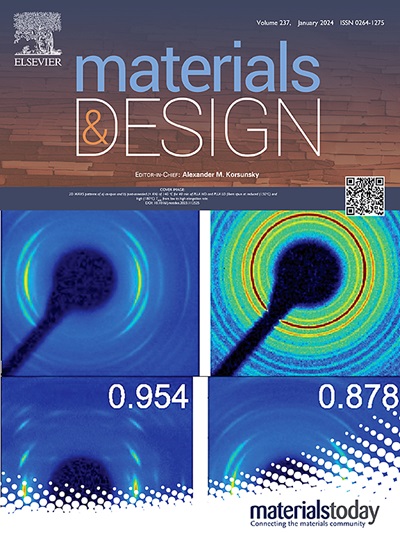电铸法制备具有自成形表皮的金属泡沫
IF 7.9
2区 材料科学
Q1 MATERIALS SCIENCE, MULTIDISCIPLINARY
引用次数: 0
摘要
金属泡沫与皮肤无界面连接,提供出色的传热,卓越的机械强度和高显微结构稳定性。本研究提出了一种创新的真空感应电铸系统和相应的方法,用于在金属泡沫上制造保形表皮。该研究结合COMSOL模拟、实验表征和力学性能评估来阐明电铸层分布的演变及其对结构性能的影响。结果表明,电铸时间的延长导致镀层厚度的不均匀性逐渐增大,而减小电流密度比调整阳极-阴极距离更能有效地改善镀层的不均匀性。力学测试结果表明,厚度超过34.6±2.4 μm的蒙皮层显著提高了泡沫的力学性能,这是由于泡沫支柱与蒙皮之间建立了足够的界面结合位点。本文章由计算机程序翻译,如有差异,请以英文原文为准。

Metal foam with self-formed skin fabricated by electroforming method
A metal foam with the interface-free connection to its skin offers excellent heat transfer, superior mechanical strength and high microstructural stability. This study presents an innovative vacuum-induced electroforming system and a corresponding methodology for fabricating conformal skins on metal foam. The investigation combines COMSOL simulation, experimental characterization, and mechanical property evaluation to elucidate the evolution of electroforming layer distribution and its impact on structural performance. The results demonstrate that extended electroforming duration leads to progressively greater thickness nonuniformity, while reducing current density proves more effective than adjusting anode-to-cathode distance for improving deposition uniformity. Mechanical testing reveals that skin layers exceeding 34.6 ± 2.4 μm in thickness substantially enhance the foam’s mechanical properties, attributable to the establishment of sufficient interfacial bonding sites between the foam struts and skin.
求助全文
通过发布文献求助,成功后即可免费获取论文全文。
去求助
来源期刊

Materials & Design
Engineering-Mechanical Engineering
CiteScore
14.30
自引率
7.10%
发文量
1028
审稿时长
85 days
期刊介绍:
Materials and Design is a multi-disciplinary journal that publishes original research reports, review articles, and express communications. The journal focuses on studying the structure and properties of inorganic and organic materials, advancements in synthesis, processing, characterization, and testing, the design of materials and engineering systems, and their applications in technology. It aims to bring together various aspects of materials science, engineering, physics, and chemistry.
The journal explores themes ranging from materials to design and aims to reveal the connections between natural and artificial materials, as well as experiment and modeling. Manuscripts submitted to Materials and Design should contain elements of discovery and surprise, as they often contribute new insights into the architecture and function of matter.
 求助内容:
求助内容: 应助结果提醒方式:
应助结果提醒方式:


